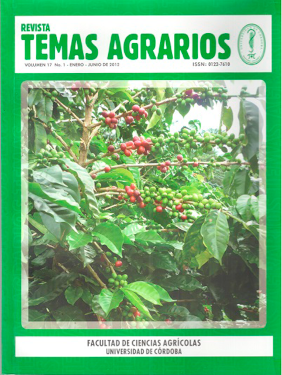Development of pulp of comun mangoes treated enzimaticamente and state with calcium, oligofructose and vitamin C.
Desarrollo de pulpa de mango común tratada enzimaticamente y adicionada con calcio, oligofructosa y vitamina C.

This work is licensed under a Creative Commons Attribution-NonCommercial 4.0 International License.
Show authors biography
The functional foods are those foods that own some Component physiologically Active (CFA) whose purpose is the one to provide a benefit for the health superior to which they contribute the traditional nutrients that contain. In this work they were developed and they were characterized physico-chemical, microbiological and sensorially three formulations of a pulp with handle that included CFA like oligo-fructose, Vitamin C and Calcium, were compared as well in front of a control pulp that non tape worm CFA. The calcium and vitamin C were introduced to the matrix of the juice in a 20% of the daily reference value (DRV). The formulations varied in the Calcium relation that was 1:1, 2:1 and 3:1, in presentations of 250 g. The Calcium, introduced like fumarate of Calcium, was the component that less solubilized being in a concentration average of 178 mg/l in the 3 formulations, vitamin C and the oligo-fructose remained constant during all the evaluation. The kinetic behavior and the sensorial analysis indicated that there was a change of color of the pulp, the best formulation was elaborated with a relation the 1:1 Calcium oligo-fructose since the judges determined that the aroma and color were similar and the best flavor and the texture with respect to the pulp control.
Article visits 1426 | PDF visits
Downloads
- Aparicio, J., Medina, A. y Lafuente, V. 2007. Descriptive sensory analysis in different classes of orange juice by a robust free-choice profile method, Analytica Chimica Acta 595(1-2):238-247.
- Bernal, I. 1993. Análisis de alimentos. Guadalupe, Bogotá, p93. Bosscher, D., Van, Bertrand, M., Van, Cauwenbergh, R. y Deelstra, H. 2003. Availabilities of calcium, iron, and zinc from dairy infant formulas is affected by soluble dietary fibers and modified starch fractions. Nutrition 19(7-8):641-645.
- Bosscher, D., Van, J. y Franck. A. 2006. Inulin and oligofructose as functional ingredients to improve bone mineralization. International Dairy Journal 16(9):1092-1097.
- Bruce, G., Schroder, T., Ian, J., Griffin, L., Specker, S. y Abrams. 2005. Absorption of calcium from the carbonated Dairy soft drink is greater than that from fat-free milk and calcium-fortified orange juice in women. Nutrition Research 25:737-742.
- Carbonell, L., Izquierdo, L. y Carbonell, I. 2007. Sensory analysis of Spanish mandarin juices. Selection of attributes and panel performance. Food Quality and Preference18(2):329-34.
- Cortés, M., Chiralt, A. y Puente, L. 2005. Alimentos funcionales: una historia con mucho presente y futuro. Vitae, Revista De La Facultad De Química Farmacéutica Universidad de Antioquia, Medellín - Colombia 12(1):5-14.
- Elleuch, M., Bedigian, D., Roiseux, O., Besbes, S., Blecker, S. y Attia, H. 2011. Dietary fibre and fibre-rich by-products of food processing: Characterisation, technological functionality and commercial applications: A review, Food Chemistry 124(2):411-421.
- Gomez-Lopez, V.M., Orsolani, L., MartinezYepez, A. y Tapia M.S. 2010. Microbiological and sensory quality of sonicated calcium-added orange juice, LWT - Food Science and Technology 43(5):808-813.
- Hernández, Y., Lobo, G. y González, M. 2006. Determination of vitamin C in tropical fruits: A comparative evaluation of methods. Food Chemistry 96(4):654-664.
- Jones, P. y Jew, S. 2007. Functional food development: concept to reality. Trends in Food Science & Technology, 18(7): 387-390.
- Quintero-Castaño, V. y Navarro, D. 2010. Diseño de un prototipo de jugo probiótico de mora con L. casei. Trabajo de Grado ingeniería agroindustrial. Universidad la Gran Colombia, Armenia.
- Quintero-Castaño, V., Duque-Cifuentes, A. L, Giraldo-Giraldo, G., Amaya– Cruz, D. y Balsero–López, C. 2011a. Caracterización Fisicoquímica Del Mango Común Durante Su Proceso De Maduración. Revista acta agronómica. Artículo en impresión.
- Quintero-Castaño, V., Duque-Cifuentes, A. y Giraldo-Giraldo, G. 2011b. Evaluación De La Viscosidad Y El Cambio De Color De La Pulpa De Mango Común (Mangifera Indica L,) Tratada Enzimáticamente. Revista Biotecnología en el Sector Agropecuario y Agroindustrial. Articulo en impresión.
- Rajkumar, P., Kailappan, R., Viswanathan, R. y Raghavan, G. 2007. Drying characteristics of foamed alphonso mango pulp in a continuous type foam mat dryer. Journal of Food Engineering 79 (4):1452-1459.
- Restrepo, A., Corté,s M. y Suárez, H. 2008. Evaluación Sensorial De Fresa (Fragaria X Ananassa Duch.) Y Uchuva (Physalis Peruviana L.) Fortificadas Con Vitamina E. Rev.Fac.Nal.Agr. 61(2).
- Singh, G. y Muthukumarappan, K. 2008. Influence of calcium fortification on sensory, physical and rheological characteristics of fruit yogurt, LWT - Food Science and Technology 41(7): 1145-1152.
- Siro, I., Kapolna, E., Kapolna, B. y Lugasi, A. 2008. Functional food. Product development, marketing and consumer acceptance--A review, 51(3):456-467.
- Thomas, R. y Gebhardt, S. 2009. Tropical Fruits and Nectars Typically Consumed in Latino Communities Are Excellent Sources of Vitamins A, C and Other Nutrients. Journal of the American Dietetic Association 109(9): A49.
- Vasquez-Caicedo, A., Schilling, S., Carle, R. y Neidhart, S. 2007. Effects of thermal processing and fruit matrix on [beta]-carotene stability and enzyme inactivation during transformation of mangoes into puree and nectar, Food Chemistry 102 (4):1172-1186.
- Vatanparast, H., Lo, E., Henry, C. y Whiting, S. 2006. A negative trend in calcium intake was accompanied by a substitution of milk by noncarbonated soft drinks in Canadian female students. Nutrition Research 26(7): 325-329.
- Villegas, B. y Costell, E. 2007. Flow behaviour of inulin-milk beverages. Influence of inulin average chain length and of milk fat content. International Dairy Journal 17(7):776-781.
- Walkling-Ribeiro, M., Noci, F., Cronin, D.A., Lyng, J.G. y Morgan, D.J. 2009. Shelf life and sensory evaluation of orange juice after exposure to thermosonication and pulsed electric fields. Food and Bioproducts Processing 87(2):102-107.
- Zaira, T., Marín, A., Cortés, M. y Montoya, C. 2010. Evaluación sensorial de uchuva (Physalis peruviana L.) Ecotipo Colombia impregnada con la cepa nativa Lactobacillus plantarum LPBM10 y la cepa comercial Lactobacillus casei ATCC 393. Vitae, Revista De La Facultad De Química Farmacéutica 17(1): 21-28.




















